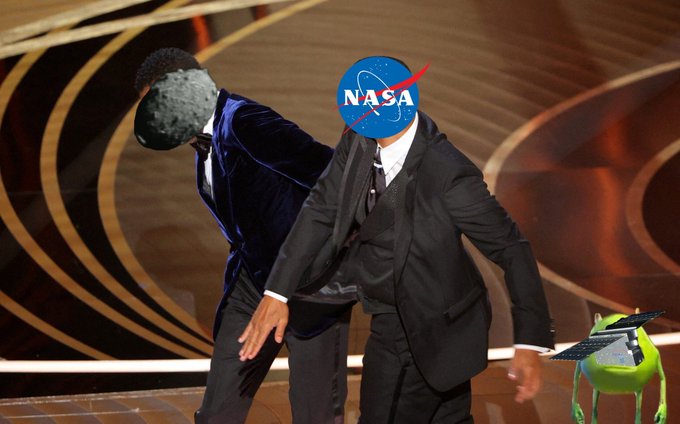By Emily Caulkett-
Tesla founder and billionaire, Elon Musk(pictured) trolled the National Aeronautics and Space Administration (NASA) with a picture of Hollywood actor Will Smith slapping his colleague Chris Rock.
Musk’s tweet referred to NASA’s DART spacecraft successfully slamming into a distant asteroid at hypersonic speed this Monday in the world’s first test of a planetary defence system, designed to prevent a potential doomsday meteorite collision with Earth.
Will Smith (with the logo of NASA on his face) can be seen slapping Chris Rock (with an asteroid on his face) at the Oscars. — Twitter/elonmusk
The Double Asteroid Redirection Test (DART) impactor hit its target, the space rock Dimorphos, at 9.14am (AEST), 10 months after blasting off from California on its pioneering mission.
“We’re embarking on a new era, an era in which we potentially have the capability to protect ourselves from something like a dangerous hazardous asteroid impact,” said Lori Glaze, director of NASA’s planetary science division.
Dimorphos — a 530-foot (160-meter) asteroid roughly comparable in size to an Egyptian pyramid — orbits a half-mile long big brother called Didymos. Never seen before, the “moonlet” appeared as a speck of light around an hour before the collision.
Its egg-like shape and craggy, boulder-dotted surface finally came into clear view in the last few minutes, as DART raced toward it at roughly 14,500 miles (23,500 kilometres) per hour.
The billionaire’s comments follow shared pictures of their successful attempt to smash a record into the Dimorphis asteroid to prove they have the capacity to redirect a similar sized asteroid or comet, if it was heading towards earth.
Nasa’s successful mission to hit an asteroid with a spacecraft going 15,000mph, in a test of their ability to alter the path of space rocks on potential collision paths with Earth, has excited both its participants and space watchers
The mission, known as Dart (Double Asteroid Redirection Test), marked humanity’s first attempt at moving another celestial body, its goal being to see if a large asteroid hurtling toward our planet could be successfully diverted.

The intentional collision was designed to test whether space rocks that might threaten Earth could be nudged safely out of the way.
DART’s goal in smashing into Dimorphos, which orbits a larger asteroid called Didymos, was to change its orbit in a test of how we might be able to deflect an asteroid heading towards Earth. While the spacecraft documented its approach to the asteroid, it was destroyed in the actual collision.
DART carried the 14-kilogram satellite in a spring-loaded box and then ejected it on 11 September so it could fly past Dimorphos at a safe distance after the collision. The move was integral to establishing how the collision affected the asteroid itself and determining whether its orbit was changed.
The first images from LICIACube depict huge plumes of debris erupting out of Dimorphos after the collision. These pictures have not been analysed by scientists yet, but eventually they will reveal information about the asteroid’s interior and how much of it was destroyed in the smash-up.
Scientists are currently uncertain of the extent to which the asteroid’s path was changed as a result of DART’s impact, but so far, the $325million mission has been considered a success.
At the moment when DART hit the rock, Mission Control’s Elena Adams declared “we have impact!” while jumping up and down in celebration.
Some have called the mission, known as Dart (Double Asteroid Redirection Test), the world’s first planetary defense mission, “which is exciting news really for everyone other than the Space Force”, Kimmel joked. “They’re like ‘can’t you let us have anything?’”
Scientists are currently unsure how much the asteroid’s path was changed as a result of DART’s impact, but so far the $325million mission has been considered a success.
At the moment when DART hit the rock, Mission Control’s Elena Adams declared “we have impact!” while jumping up and down in celebration.

The rocket weighed about 1,000 pounds, “which is kinda amazing”, Kimmel said. “Two large pigs weigh 1,000 pounds. Nasa’s plan to avoid the annihilation of humankind is basically a reverse Angry Birds.”
At about 00:20 UK time on 27 September, NASA tweeted the good news of the mission’s success by simply writing: “IMPACT SUCCESS!”
In a video recorded in the control room, a member of Nasa’s team said: “And we have impact. A triumph for humanity in the name of planetary defence.”
It took ten months for DART to come in contact with Dimorphos after launching last November on SpaceX’s Falcon 9 rocket.
Just for some context, DART needed to get to at about 13,700 miles per hour (22,000 kilometres per hour) in order for it to lay a glove on the asteroid.
The asteroids were an estimated 6.8 million miles (11 million kilometres) from Earth when the collision happened.
Space Launch System Rocket And Orien spacecraft Secured Inside Vehicle Assembly
NASA today announced that at approximately 9:15 a.m. EDT, its Space Launch System (SLS) rocket and Orion spacecraft for the Artemis I mission were secured inside the Vehicle Assembly Building at the agency’s Kennedy Space Center after a four-mile journey from Launch Pad 39B that began at 11:21 p.m. Monday, Sept. 26 ahead of the arrival of Hurricane Ian.
Teams will conduct inspections to determine impacts at the center and establish a forward plan for the next launch attempt, including replacing the core stage flight termination system batteries and retesting the system to ensure it can terminate the flight if necessary for public safety in the event of an emergency during launch.


